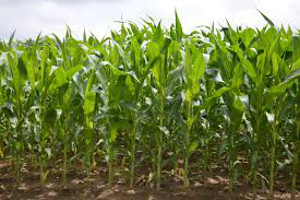 lined in Chicago, trading near a four-year low, on expectations that a bumper U.S. harvest will maintain ample global supplies. Soybeans were little changed.
lined in Chicago, trading near a four-year low, on expectations that a bumper U.S. harvest will maintain ample global supplies. Soybeans were little changed.Corn crops in the U.S., the biggest producer and exporter, are developing in the best shape in 20 years in the country’s main growing areas, U.S. Department of Agriculture data show. The agency forecasts the crop will reach 13.86 billion bushels, the second-highest on record. Crops in the Midwest have enough moisture, and warmer weather in the next 10 days probably won’t be hot enough to damage plants, forecaster DTN said today.
“The market is monitoring what the U.S. crop is doing,” Graydon Chong, an analyst at Rabobank International, said by phone from Sydney. “There’s no doubt that we continue to see a big crop coming our way.”
Corn for December delivery fell 0.6 percent to $3.845 a bushel at 7:08 a.m. on the Chicago Board of Trade. Prices rose yesterday on signs of export demand for U.S. supplies after falling to $3.7825 on July 15, the lowest since July 2010.
Corn tumbled 23 percent in the past year on prospects that a second straight bumper U.S. harvest will boost global supply. World inventories will be 188.05 million metric tons before the start of the 2015 harvest, up from 173.42 million estimated for this year and the highest since 2000, the USDA said on July 11.
Soybeans for November delivery added 0.1 percent to $11.0275 a bushel after rising 1.4 percent yesterday. The oilseed declined to $10.65 a bushel on July 11, the lowest most- active price since October 2010.
Wheat Prices
Wheat for delivery in September was little changed at $5.3725 a bushel. The most-active price fell to $5.2425 on July 14, the lowest since July 2010. In Paris, milling wheat for November delivery was unchanged at 179 euros ($242) a ton on Euronext. The price is down 8 percent in the past year.
Russia, the fourth-biggest wheat exporter, may harvest more than 100 million tons of grains for the first time since 2008, Agriculture Minister Nikolai Fedorov said yesterday. That’s more than the 97 million tons projected by President Vladimir Putin in June. The United Nations and Organization for Economic Cooperation and Development said last week that grain prices may decline in the next year or two as production remains sufficient to meet demand.
“Everyone seems to be gradually raising their estimates for production here, there and everywhere,” Dave Norris, an independent grain broker in Harrogate, England, said by telephone today. “There’s a general tone of bearishness kicking around.”





